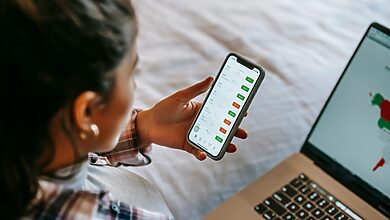Investing for Women: A Beginner’s Guide to Financial Freedom in 2025

Table of Contents
Why Investing Matters for Women in 2025
Hello there! If you’ve ever felt that investing is too complicated, too risky, or simply “not for you,” you’re not alone. As women, we often face unique financial challenges that can make the investment world seem particularly daunting.
But here’s the truth: investing isn’t just for Wall Street experts or the ultra-wealthy.
In fact, investing is one of the most powerful tools we have for building wealth, securing our futures, and achieving genuine financial freedom for women.
Why is investing especially important for women? Consider this: according to a 2024 study by the National Institute on Retirement Security, women are 80% more likely than men to face poverty in retirement. Furthermore, women typically earn about 82 cents for every dollar earned by men, creating a significant lifetime earnings gap, as reported by the U.S. Bureau of Labor Statistics.
Despite these challenges, there’s good news. When women do invest, research shows we often outperform men by nearly 0.4% annually, according to a recent Fidelity Investments study. This isn’t surprising when you consider that successful investing rewards patience, research, and a long-term perspective—qualities many women naturally bring to the table.
This comprehensive women’s investment guide is designed specifically for those who are ready to begin their investment journey. Whether you have $100 or $10,000 to start with, this article will provide you with practical, actionable strategies to build financial confidence and security in 2025 and beyond.
Let’s get started on your path to financial freedom!
Understanding Your Financial Foundation Before Investing
Before diving into specific investment strategies for women, it’s essential to establish a solid financial foundation. Think of this as preparing the soil before planting seeds that will grow into your financial future.
Assessing Your Current Financial Situation
First things first: you need a clear picture of where you stand financially. This means taking an honest inventory of your:
Income: How much money are you bringing in each month from all sources? This includes your salary, any side hustles, alimony, child support, or other regular income.
Expenses: Track everything you spend for at least one month. Categories typically include housing, transportation, food, utilities, entertainment, and miscellaneous expenses.
Debt: List all your debts, including credit cards, student loans, car loans, and mortgages. Note the balance, interest rate, and minimum payment for each.
Assets: What do you already own that has value? This might include savings accounts, retirement accounts, property, or valuable possessions.
Many excellent budgeting apps can help you track these elements automatically. Popular options in 2025 include Mint, YNAB (You Need A Budget), and Personal Capital, which now offers specialized tools for women investors.
The Consumer Financial Protection Bureau offers free financial well-being resources that can help you assess your overall financial health beyond just the numbers.
As your investment portfolio grows, explore how partnering with specialized wealth management firms addresses increasingly complex asset strategies according to financial advisors.
Building Your Emergency Fund: The Foundation of Financial Security
Before investing a single dollar, you need a financial safety net. An emergency fund protects you from life’s unexpected events—like medical bills, car repairs, or job loss—and prevents you from having to sell investments at potentially inopportune times.
Most financial experts recommend saving 3-6 months of essential living expenses in an easily accessible account. However, if you’re a freelancer, entrepreneur, or have an inconsistent income, consider aiming for 6-12 months of expenses.
Where should you keep your emergency fund? Look for high-yield savings accounts that offer:
- FDIC insurance (protection up to $250,000)
- No monthly fees
- High interest rates
- Easy access when needed
As of early 2025, several online banks offer competitive rates well above the national average, with some approaching 4-5% annual percentage yield (APY). According to Bankrate’s latest rankings, top online savings accounts are consistently outperforming traditional brick-and-mortar banks.
Pro tip: Set up automatic transfers to your emergency fund until you reach your target amount. Even small, consistent contributions of $25-50 per paycheck can build substantial security over time.
Women who excel at investing understand that implementing these long-term wealth building approaches significantly enhances investment returns as demonstrated by financial research.
Managing Debt Strategically: Clearing the Path to Investing
Addressing high-interest debt before investing significantly is generally a smart move. Why? Because the interest you’re paying on debt often exceeds the returns you might expect from investments.
For example, if you’re paying 18% interest on credit card debt but can reasonably expect a 7-10% return from stock market investments, you’re effectively losing money by investing before paying off that debt.
Consider this debt management priority list:
- High-interest debt (credit cards, payday loans) – Pay these off first
- Moderate-interest debt (personal loans, auto loans) – Consider accelerating payments
- Low-interest debt (mortgages, some student loans) – Make minimum payments while beginning to invest
The Federal Trade Commission offers guidance on debt management strategies, including how to work with creditors if you’re struggling with payments.
Remember that being debt-free is wonderful, but being investment-free can leave you vulnerable in the long run. The goal is to strike a balance that works for your unique situation.

Understanding Investment Basics: Building Your Knowledge Foundation for Women’s Financial Independence
Now that we’ve covered the financial groundwork, let’s demystify some key investment concepts. Understanding these fundamentals will help you make confident decisions as you begin your beginner investing for women journey.
Risk and Return: The Investment Relationship Every Woman Should Understand
One of the most important concepts in investing is the relationship between risk and return. Generally speaking, investments with higher potential returns come with higher risks, while safer investments typically offer lower returns.
This doesn’t mean you should avoid risk entirely. Rather, you need to understand your personal risk tolerance—essentially, how much market volatility you can handle without panicking and making emotional decisions.
Your risk tolerance depends on several factors:
- Your age and time horizon (how long until you need the money)
- Your financial goals
- Your income stability
- Your personality and emotional comfort with uncertainty
In 2025, many investment platforms offer free risk tolerance assessments to help you determine your optimal risk level. These tools typically present different scenarios of market performance and ask how you would react. Vanguard’s Investor Questionnaire is a respected resource for determining your risk profile.
Asset Classes: Where Women Can Put Their Money to Work
The investment world offers many places to put your money. Each asset class has different characteristics, including risk levels, potential returns, and how they respond to economic conditions. Here are the main asset classes to understand:
Cash and Cash Equivalents: These include savings accounts, money market accounts, and certificates of deposit (CDs). They’re very low risk but offer limited returns, especially after accounting for inflation.
Bonds: When you buy bonds, you’re essentially lending money to a government or corporation in exchange for regular interest payments and the return of your principal investment at maturity. Bonds generally offer higher returns than cash but lower returns than stocks. They’re considered moderately risky, depending on the bond issuer. The U.S. Treasury’s TreasuryDirect site allows you to purchase government bonds directly, without brokerage fees.
Stocks: Buying stocks means purchasing ownership shares in companies. Stocks have historically provided the highest long-term returns among traditional asset classes but come with greater short-term volatility. The Securities and Exchange Commission offers educational resources about stock investing basics.
Real Estate: This can include owning property directly or investing through Real Estate Investment Trusts (REITs), which trade like stocks. Real estate often provides both income (through rent or dividends) and potential appreciation.
Alternative Investments: These include commodities, cryptocurrency, art, collectibles, and more. Alternative investments often behave differently from traditional markets, which can provide diversification benefits.
The Power of Compound Interest: A Woman’s Best Friend in Investing
Albert Einstein reportedly called compound interest the “eighth wonder of the world.” It’s easy to see why when you understand how it works—especially for women, who typically live longer than men and therefore benefit even more from long-term compounding.
Compound interest means earning interest not just on your initial investment but also on the interest that accumulates over time. This creates a snowball effect that can dramatically grow your wealth, especially over long periods.
Consider this example: If you invest $5,000 today with a 7% annual return and add $200 monthly for 30 years, you’ll have approximately $283,000—even though you only contributed $77,000 of your own money. The rest ($206,000) comes from compound growth!
This illustrates why starting early is so powerful, especially for women’s financial independence. Even small amounts invested consistently can grow significantly over time thanks to compounding. The SEC’s compound interest calculator allows you to experiment with different scenarios and see the remarkable effects of time on your investments.
Investment Vehicles for Women in 2025: Options for Every Financial Goal
Now that you understand the basics, let’s explore specific investment vehicles that can help women build wealth. Each of these options has different features, tax implications, and ideal uses.
Retirement Accounts: Securing Your Future as a Woman
Retirement accounts offer significant tax advantages that can help your investments grow more efficiently. These are particularly crucial for women, who statistically live longer than men and therefore need larger retirement savings.
401(k)/403(b) Plans: If your employer offers these, they should generally be your first investment choice, especially if there’s matching contribution (essentially free money!). In 2025, you can contribute up to $23,500 annually to these accounts ($31,000 if you’re over 50), according to IRS guidelines.
Most 401(k) plans offer a selection of mutual funds or target-date funds, making them relatively simple to manage. The money is automatically deducted from your paycheck before taxes, reducing your taxable income.
Individual Retirement Accounts (IRAs): These accounts come in two main varieties:
- Traditional IRA: Contributions may be tax-deductible, depending on your income and whether you have a workplace retirement plan. Withdrawals in retirement are taxed as ordinary income.
- Roth IRA: Contributions are made with after-tax dollars, but qualified withdrawals in retirement are completely tax-free. This can be particularly valuable if you expect to be in a higher tax bracket in retirement.
For 2025, you can contribute up to $7,000 annually to IRAs ($8,000 if you’re over 50), though income limits may apply for certain tax benefits. The IRS website contains detailed information about IRA rules and limitations.
SEP IRAs and Solo 401(k)s: If you’re self-employed or a small business owner, these retirement accounts allow for much higher contribution limits—up to $69,000 in 2025, depending on your income. This is particularly relevant as women increasingly embrace entrepreneurship and freelance work.
Beyond foundational investing strategies, discover how these specialized retirement planning techniques maximize the impact of your investment approach according to retirement specialists.
Brokerage Accounts: Flexible Investment Options for Women’s Mid-Term Goals
While retirement accounts offer tax advantages, they also restrict when you can access your money without penalties. Brokerage accounts provide flexibility for goals that may occur before retirement age, such as buying a home, starting a business, or funding education.
With a standard brokerage account, you can:
- Buy and sell investments whenever you want
- Withdraw money at any time without age-related penalties
- Access a much wider range of investment options than typically available in 401(k) plans
The trade-off is that you’ll pay taxes on capital gains (profits from selling investments) and on dividends or interest you receive. However, these are generally taxed at lower rates than ordinary income if you hold investments for more than a year, as explained by the Internal Revenue Service.
Many brokerages now offer commission-free trading and fractional shares, allowing you to start investing with very small amounts of money. This democratization of investing is especially important for women looking to start investing with little money.
Popular brokerage options for women in 2025 include:
- Fidelity (offers educational resources specifically for women investors)
- Charles Schwab
- Vanguard
- Public (features women-focused investment communities)
- Robinhood (simple interface with fractional shares)
Robo-Advisors: Automated Investment Management for Busy Women
If you prefer a more hands-off approach, robo-advisors can be an excellent option, especially for busy women juggling multiple responsibilities. These automated investment platforms use algorithms to build and manage a diversified portfolio based on your goals, time horizon, and risk tolerance.
Popular robo-advisors in 2025, considered among the best investment platforms for women 2025, include:
- Betterment
- Wealthfront
- Ellevest (specifically designed with women’s financial needs in mind)
- SoFi Automated Investing
- Vanguard Digital Advisor
The advantages of robo-advisors include:
- Low fees (typically 0.25-0.50% of assets annually)
- Automatic portfolio rebalancing
- Tax-loss harvesting (for taxable accounts)
- Easy setup and management
- Low minimum investment requirements (often $0-$500)
Many robo-advisors now also offer access to human financial advisors for more complex questions, creating a hybrid model that combines technology with personalized guidance. The Consumer Financial Protection Bureau provides guidance on how to evaluate if a robo-advisor is right for your needs.

Building Your Investment Strategy: Practical Approaches for Women’s Financial Success
With an understanding of investment vehicles in place, let’s discuss how to build an effective investment strategy tailored to your personal situation as a woman investor.
Goal-Based Investing: Aligning Investments with Women’s Life Goals
One of the most effective approaches to investing is to align your strategy with specific life goals. This helps create meaningful motivation and appropriate time horizons for different portions of your portfolio.
Common financial goals for women might include:
- Retirement: Typically the longest-term goal, often 20+ years away
- Home purchase: Medium-term, perhaps 3-7 years away
- Emergency fund: Immediate access needed
- Education: Could be for yourself or children/grandchildren
- Travel or luxury purchases: Variable timeframes
- Starting a business: Often medium-term
- Career sabbatical or transition: For women planning career changes or breaks
For each goal, consider:
- The target amount needed
- The time horizon until you need the money
- The consequences if you fall short
- Your emotional attachment to the goal
This information helps determine the appropriate asset allocation—how you’ll divide your investments among stocks, bonds, and cash—for each goal. Generally, longer time horizons allow for higher risk investments (more stocks), while shorter horizons suggest more conservative allocations (more bonds and cash).
The Financial Industry Regulatory Authority (FINRA) offers excellent resources on goal-based investing strategies.
Strategic investors recognize that applying these budgeting principles ensures consistent capital deployment for maximum investment growth as shown in our financial studies.
Diversification: How Women Can Spread Investment Risk Effectively
“Don’t put all your eggs in one basket” is timeless investment wisdom. Diversification means spreading your investments across different asset classes, geographic regions, and economic sectors to reduce risk without necessarily sacrificing returns.
Effective diversification includes:
- Investing across multiple asset classes (stocks, bonds, real estate, etc.)
- Investing in different geographic regions (U.S., international developed markets, emerging markets)
- Spreading stock investments across various sectors (technology, healthcare, consumer goods, etc.)
- Including companies of different sizes (large-cap, mid-cap, small-cap)
One of the simplest ways to achieve diversification is through index funds and exchange-traded funds (ETFs), which we’ll discuss next. Morningstar’s portfolio analysis tools can help you evaluate your diversification and identify potential gaps or overlaps.
Index Funds and ETFs: Simple, Low-Cost Investment Options for Women Beginners
For most beginning women investors—and many experienced ones—index funds and ETFs represent the simplest, most cost-effective way to build a diversified portfolio.
Index funds are mutual funds designed to track a specific market index, such as the S&P 500 (large U.S. companies) or the Russell 2000 (smaller U.S. companies). Rather than trying to beat the market through active management, these funds simply aim to match the performance of their target index.
Exchange-traded funds (ETFs) are similar to index funds but trade like individual stocks throughout the trading day. This provides more flexibility but isn’t necessarily an advantage for long-term investors.
The key benefits of index funds and ETFs include:
- Low expense ratios (annual fees), often under 0.1% for major index funds
- Broad diversification in a single investment
- Minimal time required for research and management
- Consistent performance that often beats actively managed funds over long periods
A simple but effective portfolio for beginner investing for women might include just three to five broad index funds covering:
- U.S. total stock market (e.g., Vanguard Total Stock Market ETF)
- International stocks (e.g., iShares MSCI EAFE ETF)
- U.S. bonds (e.g., Schwab U.S. Aggregate Bond ETF)
- Perhaps a small allocation to real estate through a REIT index fund (e.g., Vanguard Real Estate ETF)
The specific percentage allocated to each fund would depend on your risk tolerance and time horizon. Bogleheads, a community of index fund investors inspired by Vanguard founder John Bogle, offers excellent resources for building simple, effective portfolios.

Overcoming Common Investment Barriers for Women: Breaking Through to Financial Success
Despite the clear benefits of investing, women often face unique barriers to getting started. Let’s address some of these challenges head-on and explore strategies to overcome them.
Confidence Gap: Building Investment Self-Assurance for Women
Studies consistently show that women report less confidence in their investing knowledge than men, despite evidence that women often make excellent investors. According to a FINRA study, this confidence gap persists even when controlling for actual financial knowledge.
To build confidence as a woman investor:
- Start with small amounts that won’t cause financial stress if the investment temporarily declines
- Educate yourself through reputable sources like books, podcasts, and online courses designed for beginning investors
- Consider joining women-focused investment groups or communities for support and shared learning, such as Ellevate Network or local chapters of women’s investment clubs
- Remember that even professional investors make mistakes—they’re part of the learning process, not a sign of failure
Financial education platforms like SmartHer Money and Clever Girl Finance offer courses specifically designed for women beginning their investment journey. Many public libraries also offer free access to investment courses through platforms like LinkedIn Learning or Udemy.
Pro tip: Try using investment simulators or “paper trading” accounts to practice investing without risking real money while you build your confidence. Investopedia’s Stock Simulator offers a free way to test strategies.
Income Challenges: How Women Can Invest on Any Budget
Women often face lower average incomes and career interruptions for caregiving responsibilities. According to the Institute for Women’s Policy Research, these factors contribute to a significant gender wealth gap. However, there are strategies to address this:
- Start with whatever amount you can afford, even if it’s just $25 or $50 monthly—how to start investing with little money for women is about consistency more than initial amount
- Increase your contributions when possible, such as after receiving a raise or bonus (try committing to investing 50% of any raises)
- Take full advantage of employer retirement matches, which provide an immediate 100% return on your investment
- Look for brokerages that offer fractional shares, allowing you to invest in expensive stocks with small dollar amounts
- Consider side hustles specifically to fund investments if your budget is tight
Remember, consistency often matters more than amount. A small sum invested regularly over decades can grow substantially through compound interest. The Department of Labor’s Women and Retirement Savings resource provides additional guidance.
Work-Life Balance: Making Time for Financial Management as a Busy Woman
Between career demands and disproportionate household/family responsibilities, many women report having less time for financial management. To address this:
- Use automation to make investing effortless (automatic transfers on payday)
- Consider robo-advisors for professional-quality portfolio management with minimal time investment
- Schedule regular “money dates” with yourself—perhaps quarterly—to review and adjust your strategy
- Use mobile apps that allow you to monitor investments quickly during small pockets of free time
- Consolidate accounts where possible to reduce the number of statements and platforms you need to track
Modern investment platforms have made it possible to establish and maintain a solid investment strategy with just a few hours per year of active management. For example, Fidelity Go and similar robo-advisors handle rebalancing, dividend reinvestment, and other maintenance tasks automatically.
Sustainable and Value-Aligned Investing: Making Your Money Match Your Values as a Woman Investor
Many women are particularly interested in ensuring their investments align with their values. Sustainable investing has evolved significantly in recent years, offering robust options for values-conscious investors.
ESG Investing for Women Beginners: Environmental, Social, and Governance Factors
ESG investing considers how companies perform on environmental issues (like carbon emissions), social issues (like employee treatment), and governance practices (like board diversity).
Research increasingly shows that companies with strong ESG practices often perform as well as or better than their less sustainable counterparts, challenging the old belief that values-based investing necessarily sacrifices returns. A Morgan Stanley Institute for Sustainable Investing report found that sustainable funds demonstrated competitive performance with traditional funds.
Many mutual funds and ETFs now focus specifically on ESG criteria. Some track broad market indexes but exclude companies that fail to meet certain ESG standards, while others actively seek out ESG leaders.
Popular ESG funds in 2025 include options from major providers like:
- Vanguard ESG U.S. Stock ETF
- Fidelity Sustainable Multi-Asset Fund
- BlackRock’s iShares ESG Aware ETFs
These now have expense ratios comparable to conventional index funds, making ESG investing for women beginners much more accessible than in previous years.
Impact Investing: How Women Can Direct Capital for Positive Change
Impact investing takes the concept further by deliberately directing investment capital toward specific social or environmental outcomes alongside financial returns.
Options for retail investors (everyday people, not institutions) include:
- Community development financial institutions (CDFIs) that provide loans in underserved communities, like Calvert Impact Capital
- Green bonds that fund environmental projects, available through platforms like CNote
- Microfinance funds that provide small loans to entrepreneurs in developing countries
- Specialized ETFs focused on specific impacts like gender equality, clean water, or renewable energy
While some impact investments may offer below-market returns, others are competitive with conventional investments. The Global Impact Investing Network provides resources to learn more about this growing field.
Gender Lens Investing: Supporting Women Through Strategic Investment Choices
Gender lens investing focuses specifically on advancing women’s equality and economic participation through investment decisions.
This might involve investing in:
- Companies with strong female leadership
- Businesses with good gender diversity practices
- Products and services that specifically benefit women and girls
- Financial institutions that expand access to capital for women entrepreneurs
Several ETFs and mutual funds now specialize in gender lens investing, making it accessible to everyday investors. These include the SPDR SSGA Gender Diversity Index ETF (SHE) and Pax Ellevate Global Women’s Leadership Fund.
Research from McKinsey & Company suggests companies with greater gender diversity often perform better financially, potentially making this approach both socially and financially rewarding.
Navigating Life Transitions: Investment Strategies for Key Moments in Women’s Lives
Women often face unique financial transitions that require thoughtful investment adjustments. Let’s explore some of these key life moments and how to navigate them financially.
Career Changes and Salary Negotiations: Maximizing Investment Opportunities
Career transitions represent important opportunities to advance your investment strategy. When changing jobs:
- Roll over old 401(k) accounts to avoid losing track of retirement funds—the Department of Labor offers guidance on this process
- Use salary increases to boost investment contributions before lifestyle inflation sets in
- Negotiate for better retirement benefits, not just salary
- Consider the value of stock options or equity compensation in overall compensation packages
For salary negotiations specifically, come prepared with market research on comparable positions from sites like Glassdoor and Payscale. Women often ask for less than men in negotiations, so consider naming a slightly higher figure than your target to leave room for compromise while still achieving your goal.
The American Association of University Women offers excellent salary negotiation resources specifically designed for women.
Marriage, Divorce, and Widowhood: Protecting Women’s Financial Independence
Each of these major life transitions carries significant financial implications:
Marriage: Consider whether to fully combine finances or maintain some separate accounts and investments. Discuss investment goals and risk tolerance with your partner, and establish regular financial check-ins to stay aligned. The CFPB’s guide to managing someone else’s money offers helpful frameworks for financial collaboration.
Divorce: Work with a financial advisor who specializes in divorce to understand the long-term implications of different asset divisions. Be particularly careful about retirement account divisions, which require specialized legal documents (QDROs) to avoid tax penalties. The Women’s Institute for Financial Education offers resources specifically for women navigating divorce.
Widowhood: Take time before making major financial decisions after losing a spouse. Consider working with both a grief counselor and a financial advisor during this transition, as emotional vulnerability can impact financial decision-making. Savvy Ladies provides specialized resources for widows.
For all these transitions, having your own financial knowledge and confidence is invaluable, even in the most supportive relationships.
Parenthood and Caregiving Responsibilities: Balancing Family and Financial Growth
Women still provide the majority of unpaid caregiving, which can significantly impact career earnings and investment opportunities. Consider these strategies:
- Maintain some level of retirement contributions even during reduced work hours
- Look into spousal IRA contributions if you’re temporarily out of the workforce
- Consider 529 college savings plans for children, but prioritize your retirement security first—the College Savings Plans Network provides information on 529 plans
- Explore dependent care FSAs and child tax credits to free up more money for investing
- Have open conversations with partners about fairly sharing both caregiving duties and financial responsibilities
The AARP Caregiving Resource Center offers guidance for women managing caregiving responsibilities for aging parents while balancing their own financial needs.
Remember that securing your own financial future is not selfish—it’s a form of care for your entire family and reduces the likelihood that you’ll need financial support later in life.
Investment Options for Women in their 30s: Building Wealth in a Critical Decade
Your 30s often represent a pivotal time for financial growth, when career advancement may provide more income for investing while you still have decades for compound growth before retirement.
Maximizing Retirement Contributions During Peak Earning Years
For many women, their 30s represent the beginning of significant career advancement. This makes it an ideal time to:
- Maximize contributions to employer-sponsored retirement plans
- Consider opening a Roth IRA alongside your workplace retirement plan
- Take advantage of catch-up provisions if you’re behind on retirement savings
According to T. Rowe Price research, you should aim to have 1-2 times your annual salary saved for retirement by age 35, and 3 times by age 40.
Balancing Multiple Financial Priorities
Women in their 30s often juggle competing financial goals, including:
- Building retirement funds
- Saving for children’s education
- Purchasing or upgrading a home
- Paying off student loans or other debt
The key is prioritizing these goals strategically rather than trying to accomplish everything at once. The Consumer Financial Protection Bureau offers tools to help evaluate and prioritize financial goals.
Tax-Efficient Investment Strategies
As your income grows in your 30s, tax efficiency becomes increasingly important. Consider:
- Maximizing tax-advantaged accounts before investing in taxable accounts
- Using health savings accounts (HSAs) as stealth retirement accounts if you have a high-deductible health plan
- Exploring tax-loss harvesting in taxable accounts
The IRS Tax Benefits for Education resource can help women balance investing for both retirement and educational goals.
How much money do I need to start investing?
You can start investing with as little as $5-$10 using apps that offer fractional shares. Many robo-advisors have no minimum investment requirement or start at $100. The most important factor is getting started, regardless of the amount. Charles Schwab and Fidelity both offer fractional shares with no minimum investment requirement.
Is investing too risky for my savings?
Risk in investing exists on a spectrum. While all investments carry some risk, keeping all your money in cash carries its own risk—that inflation will erode your purchasing power over time. The key is matching your investment choices to your time horizon and goals. Money needed within 2-3 years should be in conservative investments, while long-term goals can withstand more short-term volatility. The SEC’s Introduction to Risk provides an excellent overview of how to think about investment risk.
Do I need to constantly monitor the stock market?
Absolutely not! In fact, research shows that investors who check their accounts less frequently often perform better because they’re less tempted to react emotionally to market movements. For a long-term, diversified portfolio, quarterly reviews are typically sufficient.
Should I invest while I still have student loan debt?
It depends on your loan interest rates. If your loans have interest rates above 5-6%, focusing on paying those down might make more sense. However, you can still contribute enough to get any employer match in a 401(k), as that’s essentially free money. For loans with interest rates below 4-5%, you might benefit from investing while making regular loan payments.
What’s the difference between a financial advisor and a robo-advisor?
A human financial advisor provides personalized guidance, can address complex situations, and offers emotional support during market volatility. Robo-advisors use algorithms to create and manage diversified portfolios at much lower costs. Many women use a combination: robo-advisors for routine investment management and consult with human advisors for major life transitions or complex questions.
How can I learn more about investing in a way that’s not overwhelming?
Start with resources specifically designed for beginners. Books like “Broke Millennial Takes On Investing” by Erin Lowry or “Clever Girl Finance” by Bola Sokunbi offer approachable introductions. Podcasts like “So Money” and “Her Money” provide digestible financial education. Take it step by step, focusing on one concept at a time.
What tax considerations should I keep in mind when investing?
Tax efficiency is an important but often overlooked aspect of investing. Consider maximizing tax-advantaged accounts like 401(k)s and IRAs before investing in taxable accounts. For taxable investing, consider tax-efficient funds like index ETFs, which typically generate fewer taxable events than actively managed funds. Tax-loss harvesting (selling investments at a loss to offset gains) can also help manage tax liability.
How do I find a financial advisor I can trust?
Look for advisors who are fiduciaries, legally obligated to put your interests first. Consider fee-only advisors who don’t earn commissions on products they recommend. The CFP® (Certified Financial Planner) designation indicates advanced training and ethical standards. Interview multiple advisors and ask about their experience working with women in situations similar to yours.
Is cryptocurrency a good investment for beginners?
Cryptocurrency is generally considered a high-risk, speculative investment that’s not ideal for beginning investors or for large portions of your portfolio. If you’re interested in cryptocurrency, consider learning thoroughly about it first and limiting any investment to a small percentage of your overall portfolio (many advisors suggest no more than 5%).
How do I know if I’m on track with my investments?
Rather than comparing yourself to others, focus on whether you’re progressing toward your personal goals. Many financial institutions offer “retirement calculators” to help assess if your savings rate and investment strategy align with your goals. As a general benchmark, aim to have 1x your annual salary saved for retirement by age 30, 3x by 40, 6x by 50, and 10x by 67.
Taking Your First Steps Toward Financial Freedom
Investing might seem complex at first, but remember that every experienced investor was once a beginner. The most important step is simply to start.
Begin with small, manageable actions:
- Set up an automatic transfer of even $25 per month to an investment account
- Take advantage of your employer’s retirement plan if available
- Choose a simple, diversified investment option like a target-date fund for your first investments
- Commit to learning one new financial concept each month
As your knowledge and confidence grow, you can refine your strategy and increase your contributions. Remember that investing is not about getting rich quickly—it’s about building wealth consistently over time.
The financial industry is increasingly recognizing women’s unique needs and strengths as investors. Take advantage of resources specifically designed for women, including educational platforms, investment communities, and financial advisors who specialize in women’s financial needs.
Your future self will thank you for every step you take today toward financial security and independence. You have the power to transform your financial future through thoughtful, consistent investing.
This article was last updated on April 18, 2025, and reflects information available as of that date. Financial markets and regulations change frequently, so always verify current information before making investment decisions.
Disclaimer: This article is for educational purposes only and should not be considered professional financial advice. Always consult with a certified financial advisor before making investment decisions.








very interesting article. really like your work! hopefully will get more articles like that very often. Thanks
Thank you for your thoughtful feedback! We’re delighted to know our post resonated with you and offered actionable insights. Your support motivates us to continue delivering content that’s both engaging and practical. If you ever have additional questions or topics you’d like us to cover, please don’t hesitate to reach out—we’re here to help!
Warm regards,
The Fama Team
very interesting article. really like your work! hopefully will get more articles like that very often. Thanks
Thank you for your thoughtful feedback! We’re delighted to know our post resonated with you and offered actionable insights. Your support motivates us to continue delivering content that’s both engaging and practical. If you ever have additional questions or topics you’d like us to cover, please don’t hesitate to reach out—we’re here to help!
Warm regards,
The Fama Team
Your concrete examples made it easy to move from theory to action. I feel ready to implement these strategies immediately. Fantastic clarity!
Thank you for your thoughtful feedback! We’re delighted to know our post resonated with you and offered actionable insights. Your support motivates us to continue delivering content that’s both engaging and practical. If you ever have additional questions or topics you’d like us to cover, please don’t hesitate to reach out—we’re here to help!
Warm regards,
The Fama Team
I immediately shared this on my feed—it’s that good! The tips are practical, and your voice is so warm. Thank you for creating something share-worthy.
Thank you for your thoughtful feedback! We’re delighted to know our post resonated with you and offered actionable insights. Your support motivates us to continue delivering content that’s both engaging and practical. If you ever have additional questions or topics you’d like us to cover, please don’t hesitate to reach out—we’re here to help!
Warm regards,
The Fama Team
You’ve anticipated so many of my questions before I even asked them—love that! Your thorough research really shines through. I’ll definitely revisit this when I need a refresher.
Thank you for your thoughtful feedback! We’re delighted to know our post resonated with you and offered actionable insights. Your support motivates us to continue delivering content that’s both engaging and practical. If you ever have additional questions or topics you’d like us to cover, please don’t hesitate to reach out—we’re here to help!
Warm regards,
The Fama Team